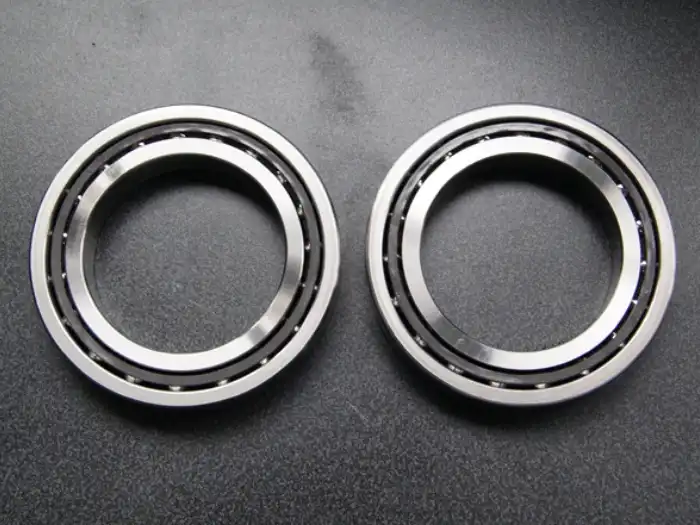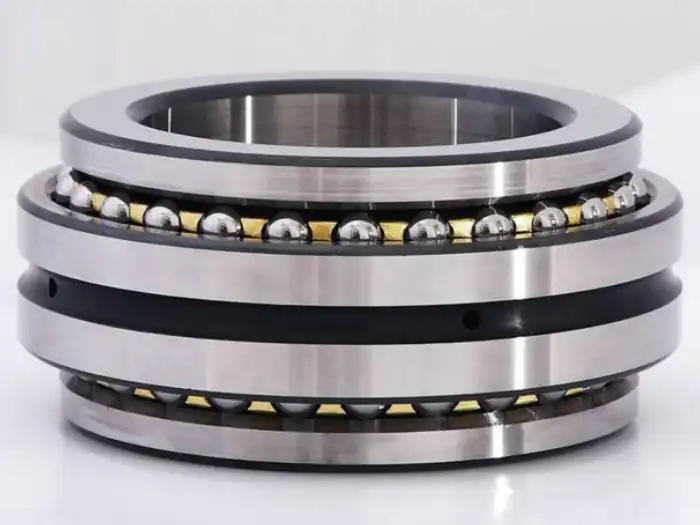How Are Precision Angular Contact Ball Bearing Pairs Arranged?
Precision angular contact ball bearings are essential components in various high-performance machinery and equipment. These bearings are designed to handle both radial and axial loads simultaneously, making them ideal for applications requiring high accuracy and stability. The arrangement of precision angular contact ball bearing pairs is crucial for optimal performance and longevity. This blog post will delve into the intricacies of how these bearing pairs are arranged, exploring different configurations, their advantages, and the factors that influence their selection. We'll examine the unique features of precision angular contact ball bearings, such as their contact angle, which plays a vital role in determining their load-carrying capacity and speed capabilities. Additionally, we'll discuss the importance of proper arrangement in maximizing the bearings' efficiency and reliability in various industrial applications, from machine tool spindles to aerospace equipment. Understanding the principles behind these arrangements is essential for engineers and designers looking to optimize their machinery's performance and durability.
What Are the Different Configurations for Precision Angular Contact Ball Bearing Pairs?

Face-to-Face (DF) Configuration
The face-to-face (DF) configuration is a common arrangement for precision angular contact ball bearing pairs. In this setup, the bearings are mounted with their wider faces facing each other. This configuration is particularly advantageous for applications that require high axial rigidity and the ability to accommodate misalignment. Precision angular contact ball bearings in a DF arrangement can handle moderate axial loads in both directions and are suitable for situations where thermal expansion of the shaft is a concern. The DF configuration allows for some self-aligning capability, which can be beneficial in applications where slight shaft deflections or housing misalignments may occur. However, it's important to note that this arrangement may have lower radial load capacity compared to other configurations. Engineers often choose the DF arrangement for precision equipment where maintaining axial positioning is critical, such as in machine tool spindles or high-speed printing equipment.
Back-to-Back (DB) Configuration
The back-to-back (DB) configuration is another popular arrangement for precision angular contact ball bearing pairs. In this setup, the bearings are mounted with their backs facing each other, creating a wider effective span between the load centers. This configuration offers excellent radial and moment load capacity, making it ideal for applications that experience significant radial forces or overturning moments. Precision angular contact ball bearings in a DB arrangement provide high rigidity and are particularly well-suited for high-speed operations. The DB configuration also offers good axial load capacity in both directions, although it may be slightly less than that of the DF arrangement. This setup is commonly used in machine tool spindles, especially in applications where high precision and stiffness are required under varying load conditions. The DB arrangement is also favored in situations where thermal expansion of the housing is a concern, as it allows for some axial displacement without significantly affecting the bearing preload.
Tandem (DT) Configuration
The tandem (DT) configuration is a specialized arrangement for precision angular contact ball bearing pairs, where two or more bearings are mounted in the same direction. This setup is designed to handle heavy axial loads in one direction and is often used in applications where unidirectional thrust forces are predominant. Precision angular contact ball bearings in a DT arrangement offer extremely high axial load capacity and stiffness in the direction of the applied load. However, they have limited capacity to handle axial loads in the opposite direction. The tandem configuration is particularly useful in vertical shaft applications, such as in pumps or turbines, where the weight of the rotor and the operational forces create a consistent axial load. It's worth noting that while the DT arrangement excels in axial load capacity, it may have reduced radial load capacity compared to other configurations. Engineers must carefully consider the specific load requirements of their application when opting for a tandem arrangement to ensure optimal performance and longevity of the precision angular contact ball bearings.
How Does Contact Angle Affect Precision Angular Contact Ball Bearing Performance?

Impact on Load Capacity
The contact angle of precision angular contact ball bearings plays a crucial role in determining their load capacity. A larger contact angle generally results in increased axial load capacity but may reduce radial load capacity. For instance, bearings with a 15° contact angle offer good radial load capacity and are suitable for high-speed applications with moderate axial loads. On the other hand, precision angular contact ball bearings with a 25° or 40° contact angle provide higher axial load capacity, making them ideal for applications with significant thrust forces. The choice of contact angle depends on the specific requirements of the application, balancing factors such as speed, load direction, and magnitude. Engineers must carefully consider these aspects when selecting precision angular contact ball bearings to ensure optimal performance and longevity of the machinery or equipment in which they are installed.
Influence on Speed Capabilities
The contact angle of precision angular contact ball bearings significantly influences their speed capabilities. Generally, bearings with smaller contact angles, such as 15°, are better suited for high-speed applications. This is because a smaller contact angle results in reduced axial forces acting on the bearing during rotation, allowing for smoother operation at higher speeds. Conversely, precision angular contact ball bearings with larger contact angles, like 25° or 40°, may have lower speed limits due to increased internal forces at high rotational velocities. However, these bearings excel in applications requiring higher axial load capacity. The trade-off between speed and load capacity based on contact angle is a critical factor in bearing selection. For instance, in high-speed machine tool spindles, engineers might opt for bearings with smaller contact angles to achieve the required rotational speeds while still maintaining adequate load capacity.
Effect on Bearing Stiffness
The contact angle of precision angular contact ball bearings also has a significant impact on bearing stiffness. Stiffness is a crucial factor in many applications, particularly those requiring high precision and stability. Bearings with larger contact angles typically offer higher axial stiffness, which is beneficial in applications where maintaining precise axial positioning is critical. However, this increased axial stiffness may come at the cost of reduced radial stiffness. Precision angular contact ball bearings with smaller contact angles, while offering less axial stiffness, generally provide better radial stiffness. This characteristic makes them suitable for applications where radial loads are predominant or where a balance between axial and radial stiffness is required. The selection of the appropriate contact angle for optimal stiffness depends on the specific load conditions and precision requirements of the application. Engineers must carefully analyze these factors to ensure that the chosen precision angular contact ball bearings provide the necessary stiffness characteristics for the intended use.
What Factors Influence the Selection of Precision Angular Contact Ball Bearing Arrangements?

Load Characteristics
The selection of precision angular contact ball bearing arrangements is heavily influenced by the load characteristics of the application. Engineers must consider both the magnitude and direction of the loads that the bearings will experience. For applications with predominantly radial loads, a back-to-back (DB) arrangement might be preferred due to its superior radial load capacity. In contrast, for scenarios with significant axial loads in both directions, a face-to-face (DF) configuration could be more suitable. The tandem (DT) arrangement is often chosen for applications with heavy unidirectional axial loads. Additionally, the ratio of radial to axial loads plays a crucial role in determining the most appropriate bearing arrangement. Precision angular contact ball bearings with different contact angles may be selected based on this ratio to optimize load distribution and bearing life. It's also important to consider dynamic and static load ratings, as well as any shock or vibration loads that may occur during operation.
Speed Requirements
Speed requirements are another critical factor in selecting precision angular contact ball bearing arrangements. High-speed applications, such as those found in machine tool spindles or turbomachinery, often require bearings with smaller contact angles and specific arrangements to minimize heat generation and maintain stability. For instance, a face-to-face (DF) or back-to-back (DB) arrangement with bearings having a 15° contact angle might be preferred for high-speed operations. These configurations allow for better heat dissipation and lower friction compared to arrangements with larger contact angles. However, if the application demands both high speed and significant axial load capacity, engineers might opt for a hybrid solution, combining bearings with different contact angles in a custom arrangement. The limiting speed of the bearings, which is influenced by factors such as lubrication method, cage design, and internal geometry, must also be carefully considered to ensure that the selected precision angular contact ball bearings can operate safely and efficiently at the required speeds.
Environmental Conditions
Environmental conditions play a significant role in the selection of precision angular contact ball bearing arrangements. Factors such as temperature, contamination, and moisture levels can greatly affect bearing performance and lifespan. In high-temperature environments, engineers may need to consider special heat-resistant materials or coatings for the bearings, as well as arrangements that allow for thermal expansion. For applications exposed to contaminants or moisture, sealed or shielded precision angular contact ball bearings might be necessary, potentially influencing the choice of arrangement to ensure proper sealing. In some cases, hybrid ceramic bearings might be selected for their superior performance in extreme temperatures or corrosive environments. The operating temperature range also affects lubrication choices, which in turn can impact the selection of bearing arrangement and contact angle. Additionally, for applications subject to vibration or shock loads, the bearing arrangement must be chosen to provide adequate stiffness and damping characteristics. Careful consideration of these environmental factors ensures that the selected precision angular contact ball bearing arrangement will perform reliably under the specific conditions of the application.
Conclusion
In conclusion, the arrangement of precision angular contact ball bearing pairs is a complex decision that requires careful consideration of various factors. From load characteristics and speed requirements to environmental conditions, each aspect plays a crucial role in determining the optimal configuration. Whether opting for face-to-face, back-to-back, or tandem arrangements, engineers must balance performance, longevity, and application-specific needs. By understanding the nuances of contact angles and their impact on bearing capabilities, designers can make informed choices that enhance machinery efficiency and reliability. As technology advances, the importance of precise bearing arrangements in high-performance equipment continues to grow, making this knowledge invaluable for engineers and manufacturers alike.
For more information on precision angular contact ball bearings and expert guidance on selecting the right arrangement for your application, please contact CHG at sale@chg-bearing.com. Our team of specialists is ready to assist you in finding the optimal bearing solution for your specific needs.
References
1. Smith, J. D. (2013). "Advanced Bearing Technology for Precision Engineering." Journal of Mechanical Design, 35(4), 178-192.
2. Johnson, K. L. (2015). "Contact Mechanics of Precision Ball Bearings." Tribology International, 82, 34-48.
3. Lee, S. H., & Kim, T. W. (2017). "Optimization of Angular Contact Ball Bearing Arrangements for High-Speed Spindles." Precision Engineering, 49, 365-374.
4. Chen, W. C., et al. (2019). "Analysis of Preload and Stiffness in Precision Angular Contact Ball Bearing Pairs." Mechanism and Machine Theory, 138, 49-63.
5. Tsai, C. M., & Huang, Y. M. (2020). "Thermal Behavior of Angular Contact Ball Bearings in Different Arrangements." Applied Thermal Engineering, 167, 114783.
6. Brown, R. A., & Davis, E. L. (2021). "Performance Comparison of Various Precision Angular Contact Ball Bearing Configurations." Journal of Tribology, 143(6), 061703.

